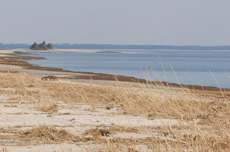Delaware Wild Lands’ history is unique
and rooted in a love of the Delaware landscape....
Concerned by increasing rates of development and land consumption throughout Delaware, a small group of motivated individuals established Delaware’s first land trust in 1961- Delaware Wild Lands – to safeguard the First State’s critical coastal and natural resources.
Together with our founding and early Board members, our founder Edmund H. “Ted” Harvey worked tirelessly to acquire critical land and water resources throughout Delaware. His great passion for the natural beauty of the First State inspired generations of Delawareans to invest in the permanent protection of critical resources in Delaware.
Delaware Wild Lands’ very first purchase was Trussum Pond near Laurel, now part of the Trap Pond State Park complex. This majestic and fragile area of old growth cypress and ponds hides under a canopy of loblolly, cedar and oak, and is reminiscent of the Deep South. For the 10 years following this purchase, Delaware Wild Lands acquired more than 1,000 additional acres in the vicinity to forever protect the ecological integrity and value of this unique habitat and its ecology.

Milford Neck
To the north in New Castle County, Shell Oil began to acquire land along the shores of the Delaware Bay to build a major oil refinery, threatening the viability of our critical bayshores area that nourish birds, shellfish, and other wildlife; filter streams and rivers; and protect the shoreline from flooding and storm surges. To thwart these efforts and the construction of the refinery, Delaware Wild Lands successfully purchased enough strategically-located land within the Shell Oil “take area” to prevent the construction of the refinery. Recognizing the need for an even greater and more comprehensive approach to the protection of Delaware’s coastal resources, Delaware Wild Lands worked in earnest alongside former Gov. Russell Peterson toward the passage of The Delaware Coastal Zone Act of 1971.
With these successes and our deep passion for land protection, Delaware Wild Lands continued to acquire the unique resources that define the diversity of habitat located throughout Delaware including 4,900 acres of impounded freshwater marsh, forest and critical waterfowl and nesting bird habitat at Augustine Creek , the Sharp Farm, and Taylor’s Bridge, all in New Castle County; 3,500 acres of coastal forest and habitat at Milford Neck in Kent County; and the largest freshwater wetlands and contiguous block of forestland remaining in Delaware, the 10,500-acre Great Cypress Swamp in Sussex County.

Bald Eagle at Great Cypress Swamp
Delaware Wild Lands is proud to have protected 31,600 acres of land throughout Delaware, 21,600 acres of which we now own, restore, and manage for Delaware’s wildlife and waterfowl habitat, freshwater and tidal wetlands, and upland and coastal forests. The remaining 10,000 acres was conveyed to the State of Delaware, including Trussum Pond; the Ted Harvey Wildlife Area/Logan Lane; Augustine Creek Wildlife Management Area, agricultural lands to the northeast of the Buena Vista Conference Center; and 700 acres of undeveloped shoreline and marsh at Angola Neck.
Today, residents and tourists alike benefit from Delaware Wild Lands’ land protection efforts. Canoeists, birders and outdoor enthusiasts marvel at the breath-taking beauty and bounty of these ecological treasures and farming, sustainable forestry, and responsible hunting remain a viable part of our local and regional economy.
